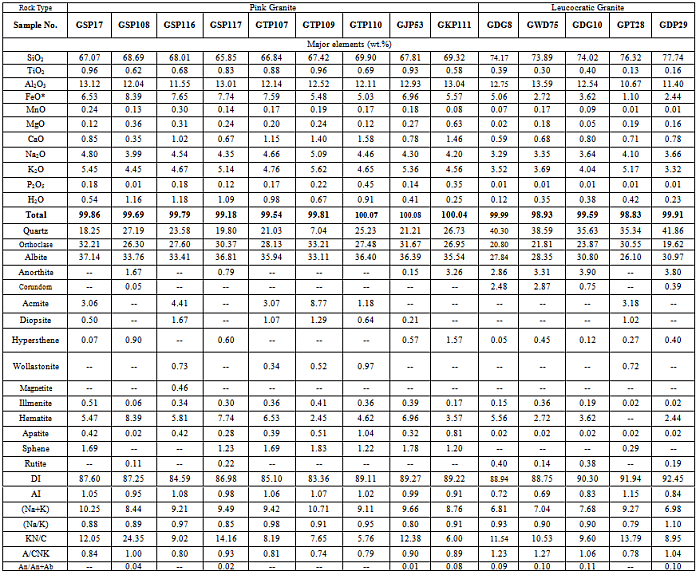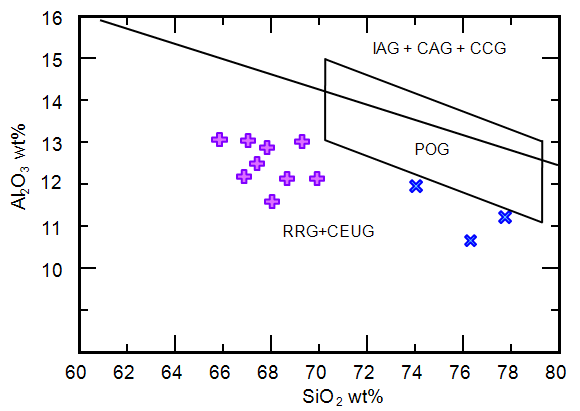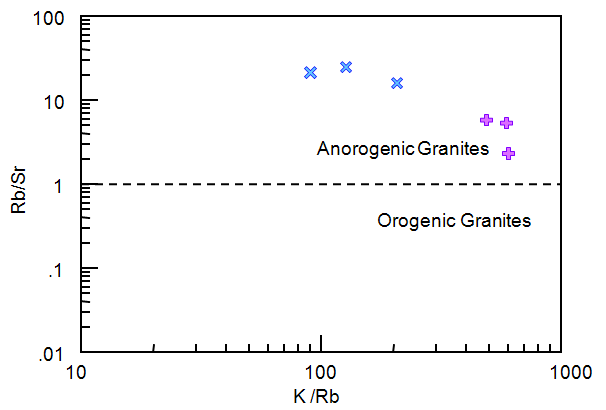| [1] | Collins, W. J., Beams, S.D., White, A.J.R., Chappell, B.W., “Nature and origin of A-type granites with particular reference to Southeastern Australia”, Contributions to Mineralogy and Petrology, vol. 80, pp. 189-200, 1982. |
| [2] | Whalen, J. B., Currie, K. L., Chappell, B. W., “A - type granites: Geochemical characteristics, discrimination and petrogenesis”, Contributions to Mineralogy and Petrology, vol. 96, pp. 407-419, 1987. |
| [3] | Eby, G.N., “The A-type granitoids: A review of their occurrence and chemical characteristics and speculations on their petrogenesis”, Lithos, vol. 26, pp. 115-134, 1990. |
| [4] | Landenberger B, Collins W. J., “Derivation of A-type granites from dehydrated charnockitic lower crust: evidence from the Chaelundi complex Eastern Australia”, Journal of Petrology, vol. 37, pp. 145-170, 1996. |
| [5] | Clemens, J. D., Holloway, J.R. and White, A.J.R., “Origin of the A-type granite: experimental constraints”, American Mineralogist, vol. 71, pp. 317-324 , 1986. |
| [6] | Anderson, J.L., “Proterozoic anorogenic granite plutonism of North America”, Geological Society of America, vol. 161, pp. 133-154, 1983. |
| [7] | Creaser, R. A., Price, R.C and Wormald, R.J., “A-type granites revisited: Assessment of a residual source model”, Geology, vol. 19, pp. 163-166, 1991. |
| [8] | Eby, G.N., “Chemical subdivision of A-type granitoids: petrogenesis and tectonic implications”, Geology, vol. 20, pp. 641-644, 1992. |
| [9] | Beyth M, Stern R.J, Altherr R, Kröner A., “The Late Precambrian Timna igneous complex, southern Israel: evidence for comagmatic- type sanukitoid monzodiorite and alkali granite magma”, Lithos, vol. 31, pp. 103–124, 1994. |
| [10] | Skjerlie K.P and Johnston A.D., “Vapor-absent melting at 10 kbar of a biotite- and amphibole-bearing tonalitic gneiss: implications for the generation of A-type granites”, Geology, vol. 20, pp. 263–266, 1992. |
| [11] | King, P.L., White, A.J.R., Chappell, B.W., Allen, C.M., “Characterization and origin of aluminous A-type granites from the Lachlan Fold Belt, Southeastern Australia”, Journal of Petrology, vol. 38, pp. 371-391, 1997. |
| [12] | Skjerlie K.P and Johnston A.D., “Fluid-absent melting behavior of an F-rich tonalitic gneiss at mid-crustal pressure: implication for the generation of anorogenic granites” Journal of Petrology, vol. 34, pp. 785-815, 1993. |
| [13] | Martin, R. F., “A-type granites of crustal origin ultimately result from open-system fenitization-type reactions in an estensional environment”, Lithos, vol. 91, pp. 125-136, 2006. |
| [14] | Kochhar, N., “Mineralization associated with A - type Malani magmatism, Northwestern peninsular India”, In: Sarkar, S. C. (Ed.), Metallogeny related to tectonic of the Proterozoic mobile belts. Oxford-IBH, New Delhi, pp. 209-224, 1992. |
| [15] | Baskar, R., Sharma, S., “An assessment of the rare metal potential of the granitoids of Siwana, Jalor, Jhunjhunu and Tusham, North Western Peninsular India”, Current Science, vol. 66, no. 1, pp. 67-69, 1994. |
| [16] | Jain, R .B., Miglani, T. S., Kumar, S., Swarnkar, B. M., Singh, R., “Rare metal and rare earth rich peralkaline, agpaiitic granitoid dykes of Siwana Ring Complex, district Barmer, Rajasthan”, Current Science, vol. 70, pp. 854-858 , 1996. |
| [17] | Vallinayagam, G., “Nb, Zr, REE rich acid dyke rocks from the Piplun area, Siwana Ring Complex, Western Rajasthan, India”, In: Paliwal, B.S. (Ed.), Geological Evolution of Northwestern India. Scientific Publishers, Jodhpur, pp. 94-102, 1999. |
| [18] | Vallinayagam, G., “A report on rare metals and rare earths in the Siwana Ring Complex, Rajasthan”, Journal of Applied Geochemistry, vol. 2, pp. 387-391, 2004. |
| [19] | Singh, A. K., Singh, R. K. B., Vallinayagam, G., “Anorogenic acid volcanic rocks in the Kundal area of the Malani Igneous Suite, Northwestern India: Geochemical and petrogenetic studies”, Journal of Asian Earth Sciences, vol. 27, pp. 544-557, 2006. |
| [20] | Singh, A. K., Vallinayagam, G., “Radioactive element distribution and rare-metal mineralization in anorogenic acid volcano-plutonic rocks of the Neoproterozoic Malani Felsic Province, Western Peninsular India”, Journal of Geological Society of India, vol. 73, pp. 837-853, 2009. |
| [21] | Chaudhary, A. K., Gopalan, K., Anjaneya Sastry, C., “Present status of the geochronology of the Precambrian rocks of Rajasthan”, Tectonophysics, vol. 105, pp. 131-140, 1984. |
| [22] | Bhushan,S.K., “Late Proterozoic continental growth: implecation from geochemistry of acid magmatic events of West Indian craton, Rajasthan”, Memorior Geological Society of India, vol. 34, pp. 339-355, 1995. |
| [23] | Bhushan, S.K., “Stratigraphic position of Marwar Supergroup, Western Rajasthan”, In: Abstract volume of the National Seminar on Stratigraphic Boundary Problems in India. Jammu, pp. 5-6, 1988. |
| [24] | Kochhar, N., “Malani Igneous Suite: Hot-spot magmatism and cratonization of the Northern part of the Indian shiled” Journal of Geological Society of India, vol. 25, pp. 155-161, 1984. |
| [25] | Bhushan, S.K., Chittora, V.K., “Late Proterozoic bimodal assemblage of Siwana subsidence structure, Western Rajasthan, India”, Journal of Geological Society of India, vol. 53, pp. 433-453, 1999. |
| [26] | Taylor, H. P. J., Forester, R. W., “Low O18 igneous rocks from the intrusive complexes of Skye, Mull and Ardnamurchan, Western Scotland”, Journal of Petrology, vol. 12, pp. 465-498, 1974. |
| [27] | Kinnaird, J.A.,“Hydrothermal alteration and mineralization of the alkaline anorogenic ring complex of Nigeria”, Journal of African Earth Science, vol. 3, pp. 229 – 251, 1985. |
| [28] | Groover, D.I., Mac Carthy, T.S., “Fractional crystallization and origin of tin deposits in granitoids”, Mineral Deposita, vol. 13, pp. 11-26, 1978. |
| [29] | Parson, I., “Alkali feldspar and Fe-Tin oxide exsolution textures as indicators of the distribution and subsolidus effects of magmatic “water” in the Klokken layered syenite intrusion, South Greenland”, Transactions Research Society, Edinburgh, Earth Science, vol. 71, pp. 1-12, 1980. |
| [30] | Yund, R.A., Ackermand, D., “Development of perthite microstructures in the strom King granites, New York”, Contributions to Mineralogy and Petrology, vol. 70, pp. 273-280, 1979. |
| [31] | Streckeisen, A. L., “IUGS Subcommission on the systematics of Igneous Rocks: Classification and nomenclature of volcanic rocks, lamprophyres, carbonatites and melilitic rocks; recommendation and suggestions”, Neues Jahrbuch für Mineralogie, Abhandlungen, vol. 134, pp. 1–14, 1978. |
| [32] | Maniar, P.D., Piccoli, P.M., “Tectonic discrimination of granitoids”, Geological Society of America Bulletin, vol. 101, pp. 635-643, 1989. |
| [33] | Rickwood P.C., “Boundary lines within petrologic diagrams which use oxides of major and minor elements”, Lithos, vol. 22, pp. 247–263, 1989. |
| [34] | Rogers, J.J.W., Greenberg, J.K., “Trace element in continental margin magmatism: Pt. III Alkali granites and their relationship to the Cratonisation: summary”, Bulletin of Geological Society of America, vol. 92, pp. 6-9, 1981. |
| [35] | Vallinayagam, G., “Minerals chemistry of Siwana Ring complex, W. Rajasthan, India”, The Indian Mineralogist, vol. 31, pp. 37-47, 1997. |
| [36] | Baskar, R., Kochhar, N., “Titan-aegirine from the peralkaline Siwana granite, Western Rajasthan, India”, Journal of Applied Geochemistry, vol. 2, pp. 133-136, 2006. |
| [37] | Frost, B. R., Barnes, C. G., Colins, W.J., Arculus, R.J., Ellis, D.J., Frost C.D., “A geochemical classification for granitic rocks”, Journal of Petrology, vol. 42, pp. 2033-2048, 2001. |
| [38] | Petro, W.L.T, Vogel T.A, Willband J.T., “Major element chemistry of plutonic rocks suites from compressional and extentional plate boundaries”, Chemical Geology, vol. 20, pp. 217–235, 1979. |
| [39] | Abdel-Rahman A.M, El-Kibbi M.M., “Anorogenic magmatism: chemical evolution of the Mount El-Sibai A-type complex (Egypt), and implications for the origin of Within- Plate Felsic magmas”, Geological Magazine, vol. 138, pp. 67–85, 2001. |
| [40] | Pearce J.A, Harris N.B.W, Tindle A.G., “Trace element discrimination diagrams for the tectonic interpretation of granitic rocks”, Journal of Petrology, vol. 25, pp. 959–983, 1984. |
| [41] | Stern R.J and Gottfried D., “Discussion of the paper “Late Pan- African magmatism and crustal development in northeastern Egypt”, Geological Journal, vol. 24, pp. 371–374, 1989. |
| [42] | Batchelor, R.A., Bowden, P., “Petrogenetic interpretation of granitoid rock series using multicationic parameters”, Chemical Geology, vol. 48, pp. 43-55, 1985. |
| [43] | Eby, G.N., Kochhar, N., “Geochemistry and petrogenesis of the Malani Igneous Suite, North Peninsular India”, Journal of Geological Society of India, vol. 36, pp. 109-130, 1990. |
| [44] | Bowden, P., “Zirconium in younger granites of Northern Nigeria” Geochimica et Cosmochimica Acta, vol. 30, pp. 985-993, 1966. |
| [45] | Kochhar, N., Sharma, R., Vallinayagam, G., “A note on tin-bearing potential of granites of the Jhunjhunu area, district Jhunjhunu, Rajasthan”, Indian Minerals, vol. 45, pp. 99-104, 1991. |
| [46] | Stony, M., “Trachytic pyroclastic from Agua de volcano, Sao Miquel Azores: evolution of a magma body over 4000 years”, Contribution to Mineralogy and Petrology, vol. 12, pp. 423-432, 1981. |
| [47] | Vallinayagam, G., Kochhar, N., “Geochemical characterization and petrogenesis of A-type, granites and the associated acid vocanics of the Siwana Ring Complex, Northern Peninsular, India”, In: Paliwal, B.S. (Ed.), The Indian Precambrian, Scientific Publishers, Jodhpur, pp. 460-48, 1998. |
| [48] | Singh, A. K., and Vallinayagam, G., “Geochemistry of the A-type granite from the Kundal area of Malani Igneous Suite, District Barmer, Rajasthan: Implications for rare metal mineralization”, Journal of Applied Geochemistry, vol. 5, pp. 16-25, 2003. |
| [49] | Vallinayagam, G., “Occurrence of Zinc rich A-type granites in the Trans-Aravalli anorogenic ring complexes, Northwestern India”, In: Shrivastava, K.L. (Ed.), Economic Mineralization. Scientific Publishers, Jodhpur, pp. 205-209, 2009. |
| [50] | Vallinayagam, G and Naresh Kumar, “Mineralization potential of the granites from Nakore ring complex, Barmer District, W. Rajasthan, India: A geochemical perspective”, Journal of Applied Geochemistry, vol. 12, no. 3, pp. 375-387, 2010. |
| [51] | Pearce, J.A., Norry, M.J., “Petrogenetic implications of Ti, Z, Y and Nb variations in volcanic rocks”, Contributions to Mineralogy and Petrology, vol. 69, pp. 33-47, 1979. |
| [52] | Pearce, J., “Sources and settings of granitic rocks”, Episodes, vol. 19, pp. 120–125, 1996. |
| [53] | Sun, S.S., McDonough, W.F., “Chemical and isotopic systematics of oceanic basalts: Implications for mantle composition and processes”, In: Norry, M.J., Saunders, A.D. (Eds.), Magmatism in the ocean Basin. Special Publication, Geological Society, no. 42, pp. 313-345, 1989. |
| [54] | Arth, J.G., “Behaviour of trace elements during magmatic process summary of theoretical models and their applications”, Revised Geophysical Space Physics, vol. 15, pp. 96-104, 1976. |
| [55] | El Bouseily A. M, El Sokkary A. A., “The relation between Rb, Ba and Sr in granitic rocks”, Chemical Geology, vol. 16, pp. 207-219, 1975. |
| [56] | Pitcher, W.S., “Granite type and tectonic environment”, In: Hsu, K. (Ed.), Mountain building process. Academic Press, London, pp. 19-40, 1983. |
| [57] | Ovchinnikov, L.N., Deposits of Lithophile rare metals. Nedra, Moscow, 1980. |
| [58] | Biste, M., “Die Anwendung geochemischer Indiakatoren auf die Zinn-Hoffigkeit herzynischer granite in sud-Sardinien”, Berl. Geowiss. Abh. Vol. 18, no.1, 1979. |
| [59] | Khin Zaw., “Geological, petrological and geochemical characteristics of granitoid rocks in Burma: With special reference to the associated W-Sn mineralization and their tectonic setting”, Journal of Southeast Asian Earth Science, vol. 4, no. 4, pp. 293-335, 1990. |
| [60] | Ekwere, S.J., “Li, F and Rb content and Ba/Rb and Rb/Sr ratios as indicators of postmagmatic alteration and mineralization in the granitic rocks of banks and Ririwqai younger complexes, Northern Nigerian”, Mineral Deposita, vol. 20, pp. 89-93, 1985. |
| [61] | Levinson, A.A., Introduction to Exploration Geochemistry. Applied Publishing Limited Wilmette, Illinois, 1974. |
| [62] | Imeokparia, E.G., “Rare metal mineralization in granitic rocks of the Tangalo anorogenic complex, Northern Nigeria”, Mineral Deposita, vol. 20, pp. 181-188, 1985. |
| [63] | Flinter, B. H., Hesp, W. R., Rigby, D., “Selected geochemical mineralogical and petrological features of granitoids of the New England complex, Australia and their relation to Sn, W, Mo and Cu mineralization”, Economic Geology, vol. 67, pp. 1241-1262, 1972. |
| [64] | Hutchison, C.S., “Granite emplacement and tectonic subdivision of Peninsular Malaysia”, Bulletin of Geological Society of Malaysia, vol. 9, pp. 187-207, 1977. |
| [65] | Dhana Raju, R., “Uranium exploration in the Proterozoic terrains of India: a petrometallographic study and implications on target selection”, Exploration and Research for Atomic Minerals, vol. 8, pp. 173-186, 1995. |
| [66] | Rogers, J. J. W., Adams, J. A. S, Thorium. In: Wedepohl, K.H. (Ed.), Handbook of Geochemistry. Springer-Verlag, Berlin, pp. 11-14, 1969. |
| [67] | Taylor, S.R., McLennan, S.M., The Continental Crust: its composition and evolution. Black-well Scientific publications, Oxford, 1985. |
| [68] | Wesserburg, G.G., “Relative contribution of U, Th and K to heat production in the Earth’s Crust”, Science, vol. 143, pp. 465- 467, 1964. |
| [69] | Hollings, P., Fralick, P., Kissin, S., “Geochemistry and geodynamic implications of the Mesoproterozoic English Bay granite-rhyolite complex, Northwestern Ontario”, Canadian Journal of Earth Sciences, vol. 41, pp. 1329-1338, 2004. |
| [70] | Menuge, J.F., Brewer, T.S., Seeger, C.M., “Petrogenesis of metaluminous A-type rhyolite from the St. Francois Mountains, Missouri and Mesoproterozoic evolution of the Southern Laurentian margin”, Precambrian Research, vol. 113, pp. 269-291, 2002. |
| [71] | Bea, F., “Residence of REE, Y, Th and U in granites and crustal protoliths implications for the chemistry of crustal melts”, Journal of Petrology, vol. 37, pp. 521- 552, 1996. |
| [72] | Taylor, S.R., “Trace element abundances and the chondritic earth model”, Geochimica et Cosmochimica Acta, vol, 28, pp. 1989-1999, 1964. |
| [73] | Dhana Raju, R., Singh, J.P and Bhattacharya, T.K., “A preliminary stydy on radioactive heat generation of some Precambrian granitic rocks of India”, Indian Journal of Earth Science, vol. 10, no. 2, pp. 112-119 1983. |
| [74] | Sharma, R., “High heat production (HHP) granites of Jhunjhunu area, Rajasthan, India”, Bulletin of Indian Geological Association, vol. 27, pp. 55-61, 1994. |
| [75] | Volker R.A., Feigenson M.D., Pation L.C., Delaney J.S., and Drake A.A. Jr., “Sr and Nd isotopic composition, age and petrogenesis of a-type granitoids of the Vernon supersuite, New Jersey Highlands, `USA”, Lithos, vol. 50, pp. 325–347, 2000. |
| [76] | Litvinovsky B.A, Jahn B M, Zanvilevich A.N, Saunders A, Poulain S., “Petrogenesis of syenite-granite suites from the Bryansky complex(Transbaikalia, Russia): implications for the origin of A-type granitoid magmas”, Chemical Geology, vol. 189, pp. 105-133, 2002. |
| [77] | Patino Douce A. E., “Generation of Metaluminous A - type granitoids by low-pressure melting of calc - alkaline granitoids”, Geology, vol. 25, pp. 743 – 746, 1997. |
| [78] | Whalen J.B, Jenner G.A, Longstaffe F.J, Robert F. and Gariépy C., “Geochemical and isotopic (O, Nd, Pb and Sr) constraints on A-type granite petrogenesis based on the Topsails Igneous Suite Newfoundland Appalachians”, Journal of Petrology, vol. 37, pp. 1463–1489, 1996. |
| [79] | Cullers, R.L., Graf, J.L., “Rare earth elements in igneous rocks of the continental crust: Intermediate and silicic rocks-ore Petrogenesis”, In: Henderson, P. (Ed.), Rare Earth Element Geochemistry, Elsevier, pp. 275-316, 1984. |
| [80] | Charoy, B Raimbault L., “Zr, Th and REE-rich biotite differentiates in the A-type granite pluton of Suzhou (eastern China): the key role of Fluorine”, Journal of Petrology, vol. 35, pp. 919-962, 1993. |
| [81] | Show, D.M., “A review of K-Rb fractionation trends by covariance analysis”, Geochimica et Cosmochimica Acta, vol. 32, pp. 573-601, 1968. |
| [82] | Wilson, M., Igneous Petrogenesis:_A global tectonic approach. Unwin Hyman Ltd. 1989. |
| [83] | Rollinson, H.R., Using Geochemical Data: Evaluation, Presentation, Interpretation. Longman scientific and technical; Copublished in the United States with John Wiley and Sons, inc., New York, 1993. |
| [84] | Leal L. R. B., Wilson T, Cunha J. C, Macambira M. J. B., “Archean tonalitic– trondhjemitic and granitic plutonism in the Gavio Block, San Francisco Craton, Bahia, Brazil: geochemical and geochronological characteristics”, Revista Brasileira de Geociências, vol. 28, pp. 209–220, 1998. |
| [85] | Chen B., Jahn B., Wei C., “Petrogenesis of Mesozoic granitoids in the Dabie UHP complex, Central China: trace element and Nd-Sr isotop evidence”, Lithos, vol. 60, pp. 67-88, 2002. |
| [86] | Ragland P.C, Basic analytical petrology. Oxford University Press, New York, 1989. |
| [87] | Kochhar, N., “The Malani Supercontinent: Middle East connection during Late Proterozoic”, In: Shrivastava, K.L. (Ed.), Economic Mineralization. Scientific Publishers, Jodhpur, pp. 15-25, 2009. |
| [88] | Bonin, B., “A-type granites and related rocks: Evolution of a concept, problems and prospects”, Lithos, vol. 97, pp. 1-29, 2007. |

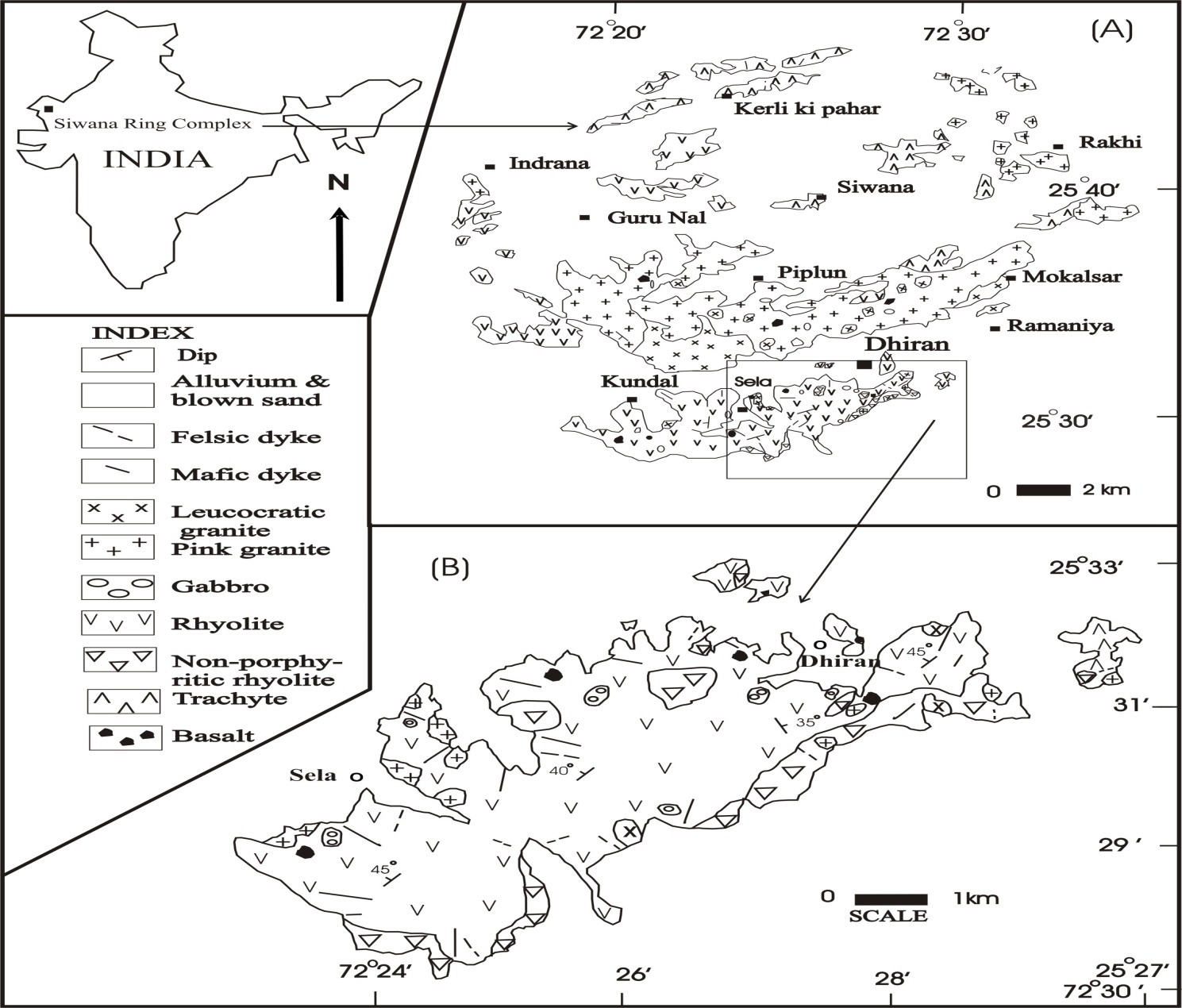

 ) and Leucocratic granite(
) and Leucocratic granite( )
)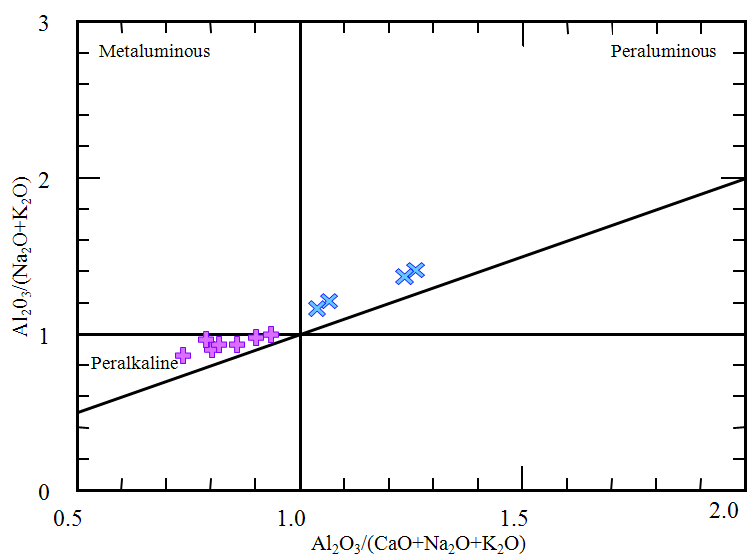
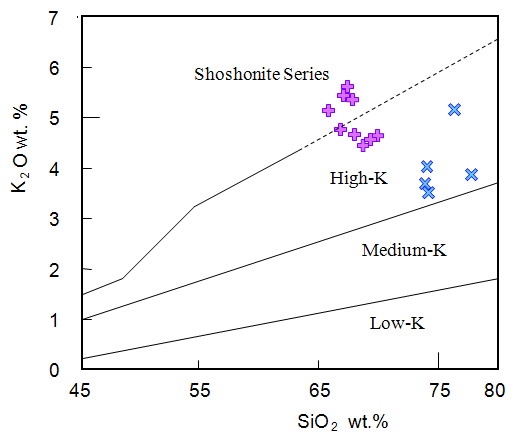
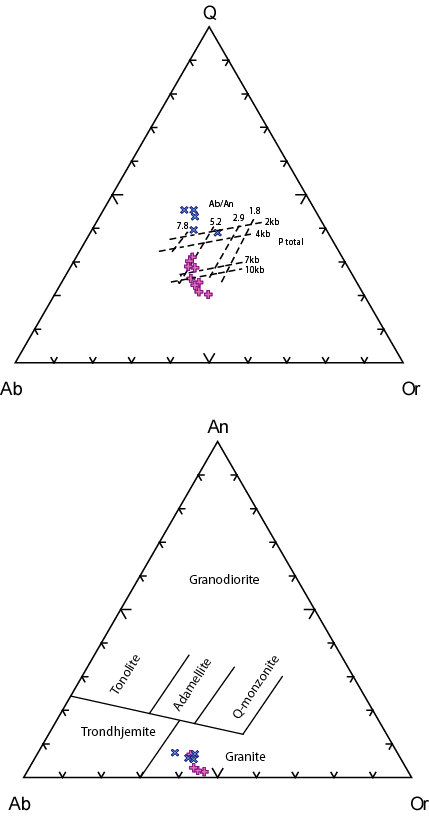
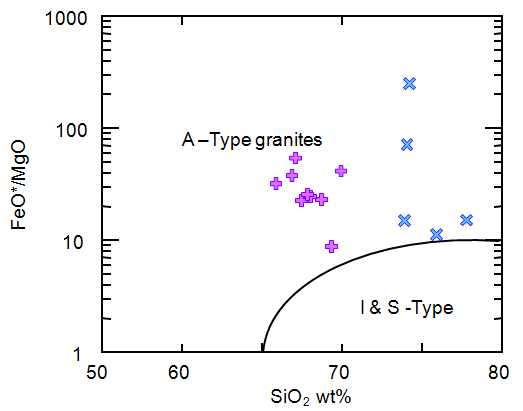


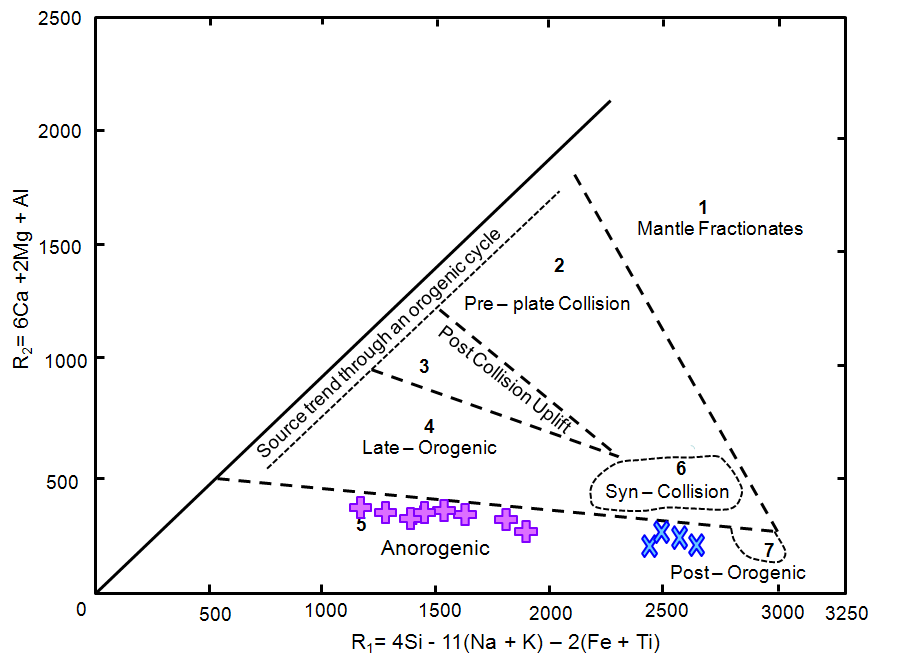
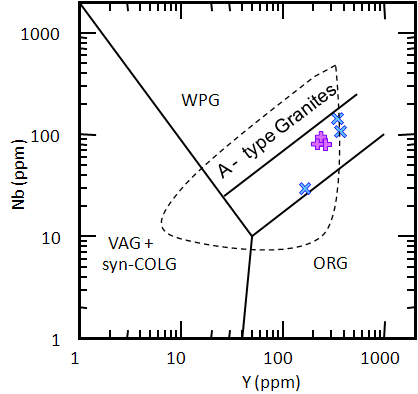



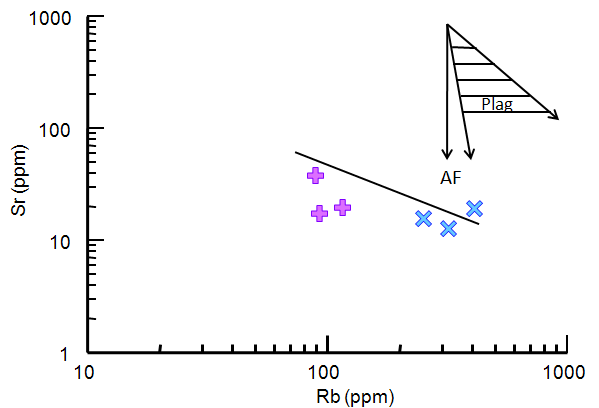


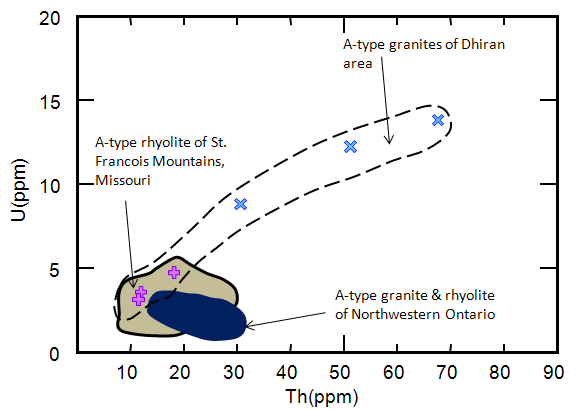
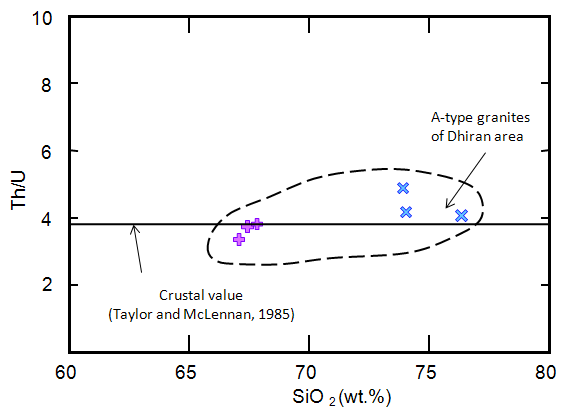
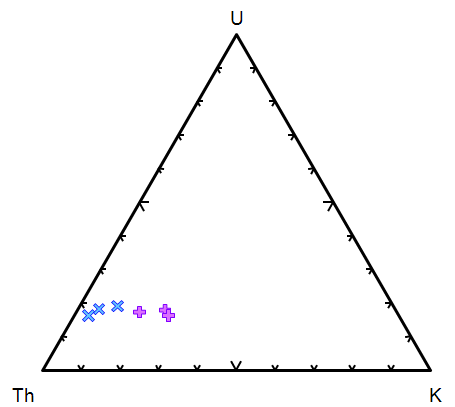
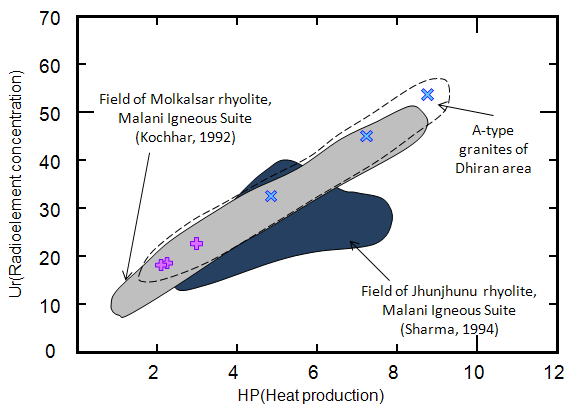
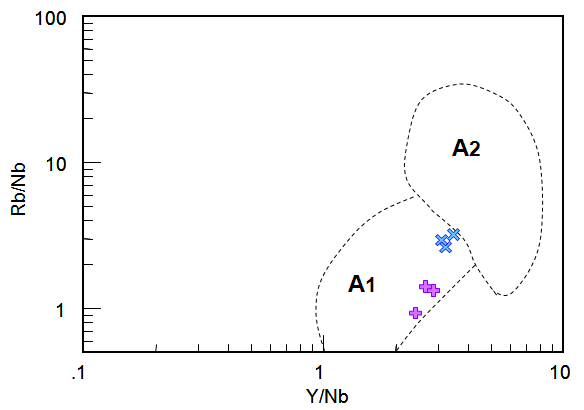

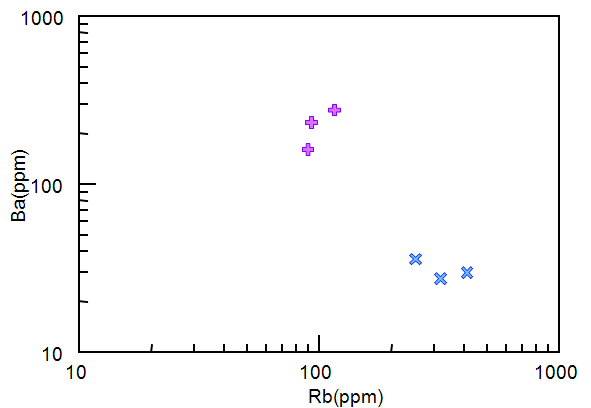
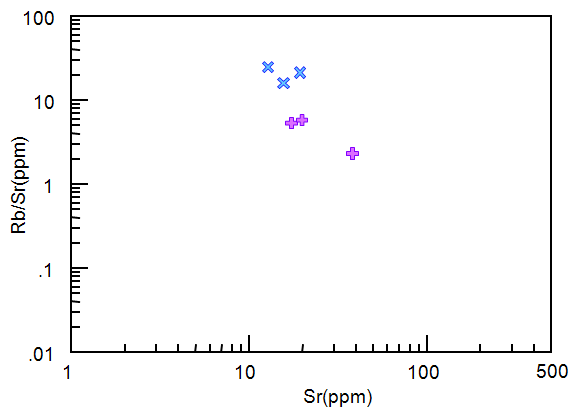
 Abstract
Abstract Reference
Reference Full-Text PDF
Full-Text PDF Full-text HTML
Full-text HTML